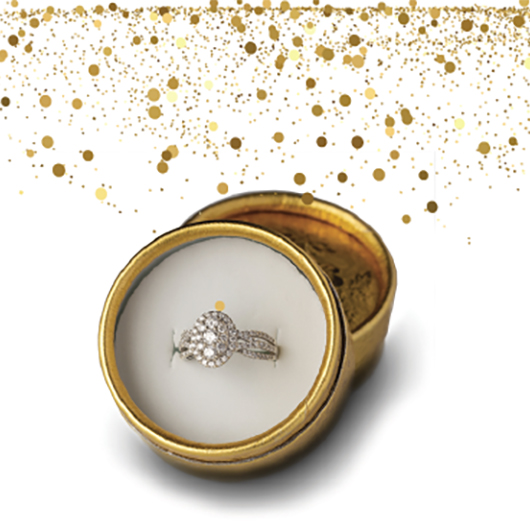Did any of your clients get engaged during the holiday season?
By Christopher W. Cook

Most of our readers probably don’t know that I also write screenplays. In one of my comedy projects in progress, a character’s engagement ring yet to be given to his significant other is stolen by hooligans. Desperate, he turns to his idiot brother who takes him to see “Jarrad,” a seedy man in an alleyway who sells jewelry from under his trench coat. (Think about the “Would You Like to Buy an O?” sketch from Sesame Street.) Hilarity ensues.
Hopefully, none of your clients have found themselves in a similar situation, which would most likely result in a claim. But since the holiday season has now passed, it’s a good opportunity to think about the jewelry your clients may have received and inform them on how to best protect it, along with the other pieces they already possess.
Appraisals
You just found out that one of your clients got engaged over the holidays and received a new diamond ring (sparkle, sparkle). An important aspect of purchasing jewelry is having the piece appraised, which is a requirement to get it insured.
“A jewelry appraisal is essential for protecting and valuing your item in case of loss, theft or damage,” says Dana Grodin, graduate gemologist and vice president of Gemcor, Inc., a Florida-based family business that provides jewelry valuations and replacements for the insurance industry. “Most insurance companies require appraisals to obtain coverage, and they should be updated every three to five years.”
“An appraisal is also typically needed if a claim is made to ensure that any repair or replacement equals or exceeds the quality of the damaged or lost piece,” adds Ben Glispie, national agent channel lead, at BriteCo, a Chicago-based provider of jewelry insurance. “Whenever you purchase a piece of fine jewelry, the vendor selling the piece will likely provide an accompanying appraisal document, often at no charge, although some might provide them with a fee.”
“The appraiser carefully evaluates every detail of the jewelry, including the gemstone’s ‘Four Cs’ [carat, cut, color, clarity], along with the weight, metal composition and craftsmanship of the mounting,” says Ali McLaney, founder and CEO of Digipraise, a “spin-off” company of Gemcor that provides digital appraisal and remote valuation services. “All those details are being evaluated by a credentialed appraiser, hopefully a graduate gemologist, to help them determine the appraisal value.”
But like fine wine, the value of a jewelry item can change over the course of time; some pieces go up in value while others go down. This is why updated appraisals are a must for your clients’ jewelry.
“The updated appraisal is important because it shows [your clients] that you’re aware of market fluctuations,” McLaney says. “We were starting to see a lot of people underinsured when they had a claim because they never updated the appraisal of the insured item. They purchased a policy through an agent or direct from a carrier and had been paying for that same value for 10, 15, or 20 years; never did anyone suggest updating it. It’s devastating to lose a piece of jewelry because of its sentimentality, now imagine the salt on the wound of being underinsured and having to pay out of pocket.”
An updated appraisal can also benefit your clients if a piece of jewelry has decreased in value. “With the market as volatile as it is right now, you may be able to save your clients some premium if they get an updated appraisal and the piece has dropped in replacement cost value,” McLaney notes.
Partnering with a digital jewelry service can also be beneficial for your clients because of the ability to attach photos to appraisals. “Adding a photo to the appraisal will allow for a better claim experience because it allows the carrier’s valuator to have more accuracy in their replacement quote when they can see what the piece looks like,” McLaney says. “It’s also easier to recreate the item for a customer if they have a photo on the appraisal to reference.”
“Your job as an agent is to protect
your customer, and having an
updated appraisal gives you an
opportunity to ensure accurate coverage and
possibly shop the best policy for them.”
—Ali McLaney
Founder and CEO
Digipraise
lPhotos also show that the customer is in possession of the asset and that the piece matches the description provided on the initial appraisal.
“Digipraise takes the current condition of the asset and looks at the existing description and comes up with a new value, bringing the person current with valuation,” McLaney says. “Your job as an agent is to protect your customer, and having an updated appraisal gives you an opportunity to ensure accurate coverage and possibly shop the best policy for them.”
Coverages
When talking about insuring jewelry, some of your clients might respond with something like, “my homeowners policy will take care of that.” This isn’t always the best option, as stand-alone policies have become more popular.
As documented in a research report titled The Homeowners Insurance Crisis and Stand-Alone Jewelry Polices, BriteCo recently surveyed homeowners insurance agents across the country, revealing that 50% of agents recommend stand-alone jewelry insurance rather than putting jewelry on a homeowners rider or floater. Why is that?
“A jewelry claim made on a homeowners insurance rider or floater would typically be reported to databases like CLUE (Comprehensive Loss Underwriting Exchange) and A-PLUS (Automated Property Loss Underwriting System),” says Glispie. “Having such a claim on your record could affect your ability to obtain affordable homeowners coverage in the future, as insurers use these reports to evaluate risk—and that claim will stay on your record for up to seven years. That means your homeowners premium could go up, or your policy canceled or non-renewed.”
Stand-alone jewelry policies, such as those provided by BriteCo, do not report jewelry claims to CLUE or A-PLUS, so any claim would not impact a homeowners premium or risk a non-renewal.
“At a time when most homeowners are experiencing unprecedented levels of premium increases and non-renewals, it makes sense to avoid anything that might impact an existing homeowners policy or your search for alternative carriers,” Glispie adds. “In addition, stand-alone jewelry insurance is typically very affordable, starting at $5 a month for a $4,000 engagement ring (depending on your location) or from .5% to 1.5% of the item’s appraised value.”
“For existing clients, agents need to have
a conversation explaining the risks
of leaving higher-value jewelry items
on a homeowners’ rider or floater.”
—Ben Glispie
National Agent Channel Lead
BriteCo
Stand-alone jewelry policies also provide an extra addition for a portfolio. “A lot of agents like the stickiness of managing multiple policies for a client,” McLaney says. “By moving the jewelry to a stand-alone policy, agents see it as an additional touchpoint that strengthens their relationship with the customer.”
When it comes to policies, some jewelry stores have partnered directly with jewelry insurance providers “to get a no-obligation quote once the jeweler has conducted an appraisal, such as on a newly purchased engagement ring,” Glispie says.
McLaney says to be cautious of this. “Most jewelers now utilize appraisal software provided to them for free from an insurance carrier,” she says. “Typically, a jeweler will have only one software and one carrier partnership. If you send your customer to a jewelry store for an updated appraisal, there’s a risk the carrier could offer them a policy directly, bypassing your relationship with the customer.”
While you can’t always control whether a jeweler provides an appraisal or if an insurance quote comes from the carrier partner on new purchases, McLaney stresses the importance of offering clients independent solutions like Digipraise for appraisal value updates. “This is an opportunity to not only educate your customers about their options but also to allow the agents to position themselves as a knowledgeable resource. Educating the customers about the need for appraisal updates as well as the different types of policies is a great way to build trust,” she says.
So, what are the different ways that a piece of jewelry can be insured?
“Some carriers offer an ‘agreed value’ policy,” McLaney says. “Under this policy, the appraised value submitted by the agent to the underwriter is the amount the carrier agrees to pay in the event of a claim.
“For example, if you insure your Rolex for $24,000 and lose it, the insurer will issue a check for $24,000. That’s the essence of agreed value insurance,” McLaney explains. “Agreeing to the value ahead of time can make claims easier to resolve, although these policies often come with a higher premium.
“Every year when an insured is up for renewal,
send a reminder to consider adding their
new jewelry to their insurance coverage and also
updating their current appraisals if it’s been more
than five years since their jewelry was last appraised.”
—Dana Grodin
Vice President
Gemcor, Inc.
“A lot of people are under the assumption that that’s the policy they bought,” she adds, “and I don’t know whether it’s miscommunication or a lack of information, but they have a claim and they think that they’re getting a check for the insured amount.
“The other types of policies we see for jewelry are replacement cost value or actual cash value, which are two very different things,” McLaney explains. “With replacement cost value, the insurance company pays the amount needed to repair or replace the item at today’s cost (with a cap at the scheduled amount), without factoring in depreciation. Actual cash value, however, takes depreciation into account. It’s essentially what someone would pay for the jewelry as a used item—like if you were selling it on eBay.”
Best practices for agents
When it comes to your clients’ jewelry, be educated about the options available for coverage and don’t forget to communicate with them.
“For existing clients, agents need to have a conversation explaining the risks of leaving higher-value jewelry items on a homeowners rider or floater,” Glispie says. “Make sure that [your clients] get jewelry insurance (preferably a stand-alone jewelry policy) as soon as a jewelry item is purchased.”
“If a piece of jewelry’s not individually added to the policy, there is usually a pool of coverage for unscheduled jewelry, but it is very important that agents know the policy limit, the per-item limit and the deductible and that they explain this to their customers,” McLaney adds. “If your client has a limit of $3,000 and has a claim with a piece of jewelry that’s [valued at] $5,000 and you did not encourage them to insure it, schedule it by itself, or there wasn’t an appraisal, they’re capped at $3,000 and now incur an out of pocket [expense] to replace it.”
“Agents should explain [to their clients] how their policies work and the differences between an agreed value policy and a replacement cost policy,” adds Grodin. “Most important, agents should explain to their clients that most policies do not automatically adjust higher for inflation or lower for depreciation. It is the insured’s responsibility to keep their appraisals updated so they are adequately protected.
“Every year when an insured is up for renewal, send a reminder to consider adding any new jewelry purchases to their insurance coverage and also to update their current appraisals if it’s been more than five years since their jewelry was last appraised.”
McLaney concludes: “It’s crucial for agents to be well-informed about the options available for their clients. Jewelry may be a small part of the overall portfolio, but it’s a high-value and sentimental asset that deserves proper attention. Ensuring clients have the right coverage for their jewelry can make a significant difference when a claim arises.”
For more information:
BriteCo
Brite.co
Digipraise
Digipraise.com
Gemcor
Gemcor.net





